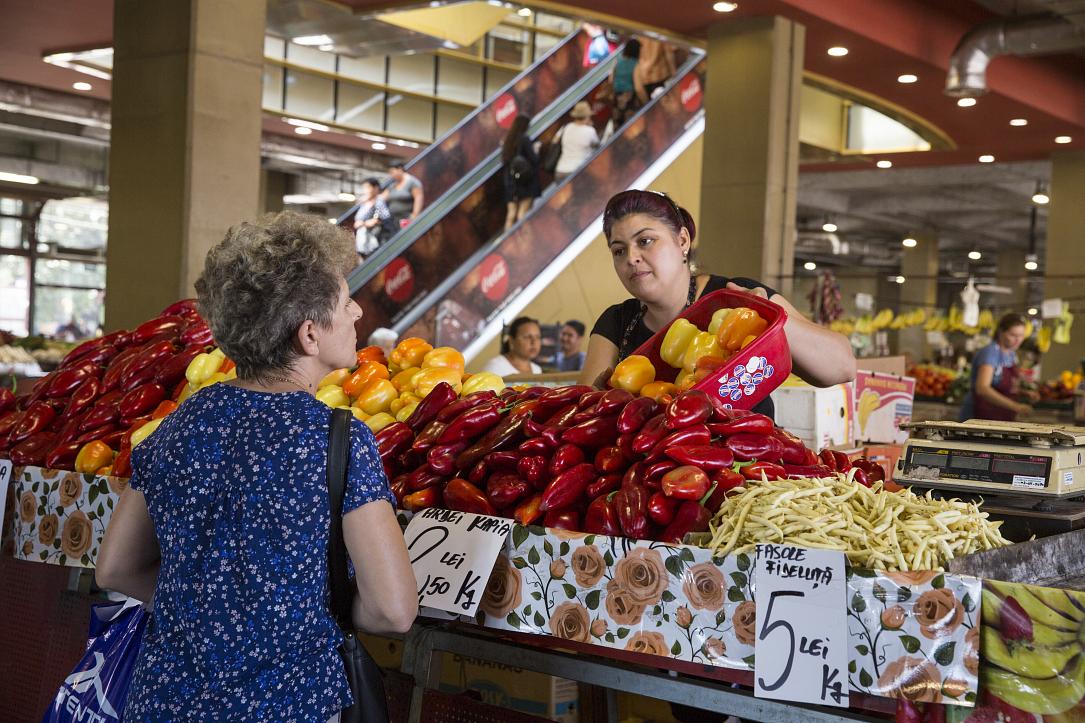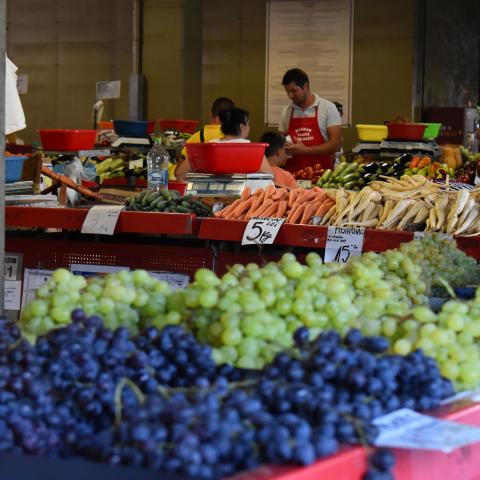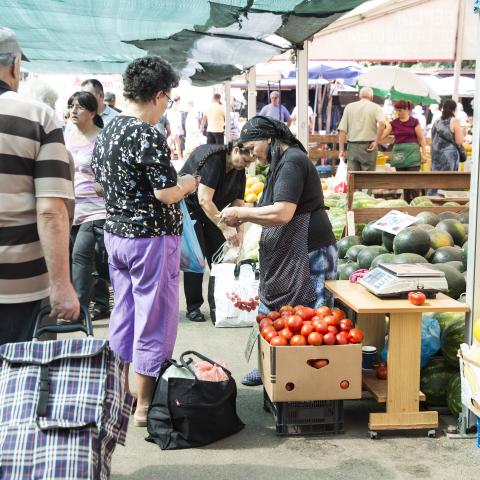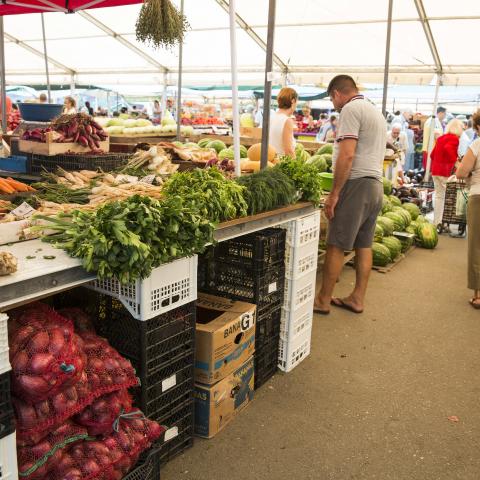„Destination: Bucharest” - Traditional markets in the Capital

Between the expansion of supermarkets and hypermarkets and the emergence of the bio product stores niche, the traditional markets have kept their place in the city’s texture. Many have been modernized, others relocated, but beyond the logistic transformations they carry on with a traditional retail form that is also adapted to a new generation of customers. It is during autumn and spring when Bucharest best reveals itself through its markets.
Upon exiting the underpass of the Obor subway, in the eastern part of the city, one needs to walk past a mix of counters and wooden stalls where any one thing can be found on sale: from discounted books and underwear to traditional Romanian blouses, wooden spoons and cutlery, interior design items and clothes. Making way between them, you pass by the Bucur Obor Store, a city landmark since the communist period. The store is probably one of its kind in Bucharest: it hosts a variety of stores and products, from haberdasher’s and fabric stores to leather goods, tailor’s and watch repair shops.
You can discover the Obor Market behind the store. It is one of the oldest and largest in Bucharest. During the 17th century, it was known as a fair where animals were sold – hence the name, the obor was the place where livestock, hay or wood were sold. It became a public market in 1865; livestock is no longer sold here, now it is the place where thousands of Bucharest residents shop daily. Even Richard Nixon, the former president of the United States, stopped here during his visit in Romania in 1969.
We do not know what the U.S. president bought then but now, with its modernized halls that did not take anything away from the area’s charm and charisma, the Obor Market is a must-see. At 5 in the afternoon the market is not very crowded, and the morning’s liveliness has made way to the torpor of a very warm, summer-end afternoon. The counters are filled and the sellers entice passersby with their goods.
One father is pushing the child’s stroller between the stalls and, on the phone, reports on what he has bought: fruits, tomatoes, “everything”. Because the market is not only large but also well-stocked, with all the season’s produce, from tomatoes, eggplants and bell peppers to watermelons and corn, sold by producers from all over the country. Next to cranberries, blackberries and raspberry one can find seabuckthorn, aromatic plants, lavender, thyme and walnut kernels, borș (a liquid used in the making of local sour soups) and apple juice. One sign of the modern times: on the first level of the market there is a milk dispenser machine, alongside an orange juice one, sitting next to the coffee vending machine.
The labels not only display the price but also praise the qualities of the product: “good”, “fresh”, “tasty”. One label in front of a stall with tomatoes warns onlookers: “Do not press!” Two very ripe and juicy halves of a tomato on display nearby provide the explanation for the interdiction. At a stall close by, a seller is arranging pears in orderly rows, one next to the other, then one on top of the other, in the shape of a pyramid base. And if you don’t get around to read the labels, the sellers praise their merchandise and invite you to buy when stopping in front of a stall.
It takes about an hour to discover the entire universe of Obor Market. On the first level, fruits and vegetables are sold in the main hall, including at outside stalls. The first level hosts butcher’s shops, shops selling dairy and cheese products, many of which market themselves with the availability of local, bio or eco products – some have regular customers and are always busy.
You can find here stores selling medicinal and aromatic plants (plafar), natural and honey-based products and also a playground for children. Another area, on one side of the market, is dedicated to products for fishermen. There is also an area where fish is sold, and, close by, stalls selling detergents, spices, sweets and biscuits, carpets and interior design items, and repair or key duplicate shops.
The colorful world of the traditional market is to be found, at a smaller scale, in many of the city’s neighborhood markets.
In the Capital’s district 3, the Râmnicu Sărat Market, at the intersection of the Liviu Rebreanu and Camil Ressu boulevards, is the place where the residents of the Dristor neighborhood come to shop for fresh produce. It is an open-air market, with stalls covered by umbrellas. Smaller than Obor, the market is surrounded by kiosks and small shops selling pretzels and pastry products, meat and cheese products, stalls selling clothing, flower kiosks, a shop selling pet food, and a pillow cleaners service. All the fruits and vegetables in season are found here as well and those who don’t have the time or don’t know how can also buy from here pickled cabbage, pickles, borș or țuică (a plum brandy).
When someone approaches them for a purchase, the sellers attend to them promptly, and when the market is quiet and the buyers few, they talk among themselves. One seller is walking around with two ropes of garlic and is trying to convince passersby to buy some. In the corner where watermelons are found, the sellers have adapted to a new segment of clients and are selling slices or quarters of melon, wrapped up individually, just like at the supermarket. Here, as it happens in other markets, the regular customers have their favorite sellers for certain type of products, and conversations pick up easily.
Another important market of the Capital, although a niche one, is the George Coșbuc Flower Market, dedicated to the flower trade. This is where smaller flower shops come to stock up but the market is also open to individual buyers, who can find here a varied offer at better prices compared to other flower shops in town. The area where the market is located is an important one for the history of the Capital, and hosts some of the buildings that survived the demolitions that took place in the 1980s in the Uranus neighborhood. The former building of the Commodities Exchange is found close to the market. It has been refurbished and it is now used as an office and event space.
editor@romania-insider.com
(Photos by Romania-Insider.com for AMPT)
Useful information
Bucharest markets
Obor Market
Address: 4 Ziduri Moşi St.
piataoborbucuresti.ro
Crângași Market
Address: 29 Calea Crângași
Amzei Market
Address: 10 -22 Piața Amzei St.
Domenii Market
Address: 128 Ion Mihalache Blvd.
George Coșbuc Flower Market
Address: 169 Calea Rahovei
Drumul Taberei (Moghioroș) Market
Address: 40 - 44 Drumul Taberei
Gemeni Market
Address: 103 – 107 Vasile Lascăr St.
Berceni Market
Address: 35 – 37 Șoseaua Berceni
Norilor Market
Address: 9 Constantin Rădulescu Motru St.
To keep in mind:
Most markets open starting 7 – 7:30 AM. During summer months, they stay open until after 18:00 but close earlier during winter.
You can find traditional products such as jams, spreads or preserves at the fairs that take place in markets, or at the Village Museums, and sometimes in the yard of the Agriculture Ministry, close to the city’s University Square.
Traditional season recipes
Magiun – Plum Jam
This jam is made out of very ripe plums, boiled, without sugar, until a very thick paste is obtained. The Topoloveni variety received since 2011 the Protected Geographical Status from the European Union.
Grilled Eggplant Spread
A very popular dish in Romanian kitchens during summer, it is made from grilled eggplants, chopped until spread like, and mixed with oil and chopped onions.
This material is part of a project under the program of promoting the touristic heritage "Destination: Bucharest", carried out by the Bucharest City Hall through the Public Monuments and Touristic Heritage Administration (AMPT).


















